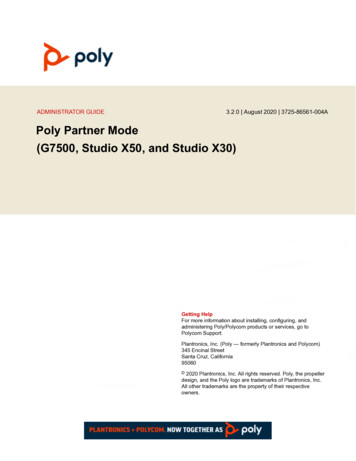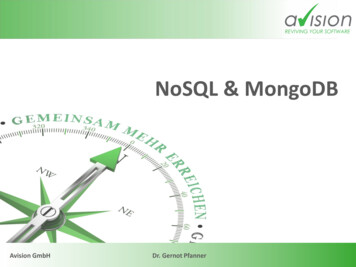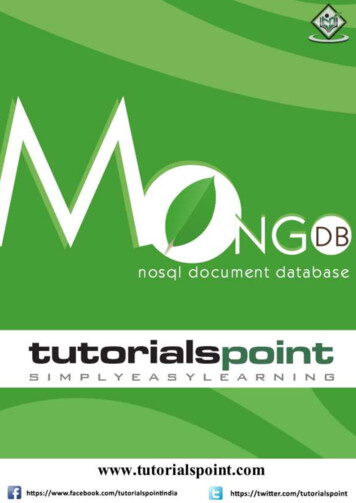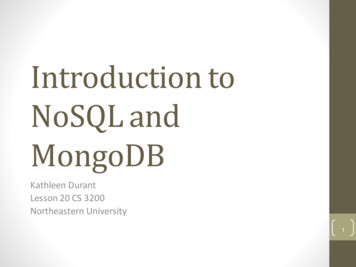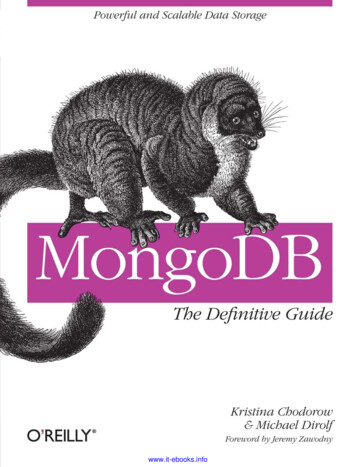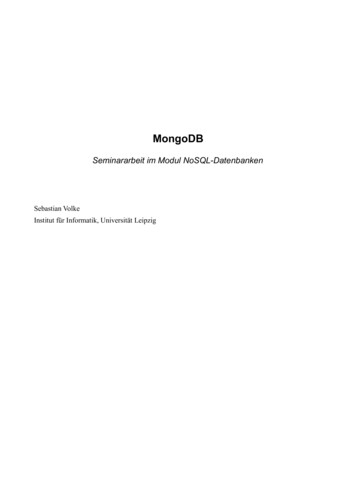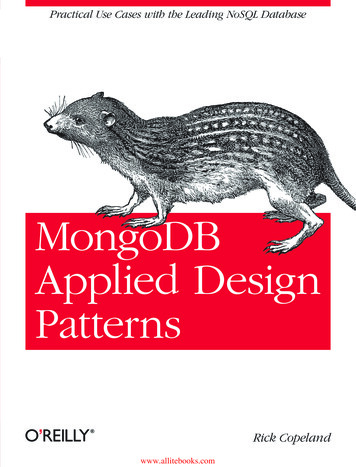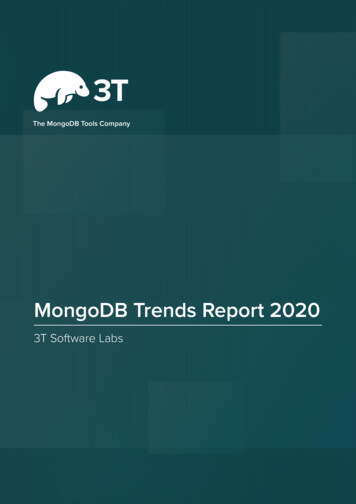
Transcription
The MongoDB Tools CompanyMongoDB Trends Report 20203T Software Labs
Table of ContentsKey Findings3MongoDB and other database technologies4Polyglot data in the cloud8Data differences in the cloud9Moving MongoDB to the cloud10Concerns about cost vs. performance11MongoDB Atlas and the DBaaS wave13Methodology14Further Reading18With commentary fromMatthias GelbmannCo-FounderDB-EnginesAndrew DavidsonVP, Cloud ProductsMongoDBKimberly WilkinsMongoDB Technical LeadPerconaPage 7Page 9Page 112
OverviewThis report reviews MongoDB usage trends, including cloud adoption and MongoDB’s use alongside traditionalrelational database technologies and newer, NoSQL database technologies. The results are based upon over16,000 responses from developers, DevOps engineers, DBAs, systems architects, C-level executives andbusiness founders, all running MongoDB in production. They were collected through a series of online surveysconducted between June 2017 and September 2020.Key Findings The number of developers abandoning SQL technologiescontinues to increase.Page 6 NoSQL databases are being moved to the cloud faster thantheir SQL counterparts.Page 9 Europe (EMEA), arguably because of GDPR, is significantlybehind the rest of the world in moving data to the cloud.Page 10 Growth of MongoDB Atlas, especially the paid tier,continues at breakneck speed.Page 12 MongoDB's considerable growth in the last few years hasbeen accompanied by a rising tide in NoSQL technologiesacross the board, often at the expense of less scalable SQLsystems.Page 63
MongoDB and other databasetechnologies4
With the growth of analytics and the rise of big data, it is unsurprising that database sizes are growing fasterthan ever. In just two years we’ve seen fewer and fewer MongoDB users with small databases of less than 10gigabytes, and more and more users with large databases. In 2017, less than 3% of MongoDB users reportedtheir largest database was over 1 terabyte. In 2020, that number has tripled to over 9%.Figure 1.01 Size of largest database over time60 %56.2 %Less than 10GB10GB - 100 GB100GB - 1TBOver 1TB53.3 %42.7 %40 %20 %9.3 %4.0 %2.8 %201720182020Databases are getting bigger, but developers are also using more of them, employing more databasetechnologies every year. In 2017 a MongoDB user only used on average 2 different technologies, eitherrelational or non-relational. In 2020, the average is over 3 per user.Figure 1.02 Average number of different database technologies per MongoDB user over time4.0All databasesNoSQL databasesSQL databases3.02.01.00.020172018201920205
On the one hand there’s been a 26% increase in developers abandoning SQL altogether, reporting “We don’tuse SQL.” On the other hand, there’s been a 20% decline in users who claim MongoDB is the only NoSQLtechnology they use.Figure 1.03 SQL databases used alongside MongoDB by technology2018202052.7 %MySQL45.4 %30.7 %PostrgeSQL37.7 %26.2 %Microsoft SQL Server25.4 %15.6 %SQLite13.5 %21.3 %Other21.9 %16.0 %We don't use SQL20.1 %Figure 1.04 NoSQL databases used alongside MongoDB by technology2018202033.3 %Redis42.4 %23.5 %ElasticsearchDocumentDB/DynamoDBCassandraOtherWe only use MongoDB24.0 %1.1 %15.7 %6.3 %7.5 %9.1 %4.7 %45.7 %36.6 %The overall picture looks like a steady move toward polyglot database estates that deploy the right database forthe job at hand. With this burgeoning data-Babel, it’s the big NoSQL workhorses of Redis, Elasticsearch, andCassandra that are being co-opted alongside MongoDB, at the expense of MySQL and Microsoft SQL Server.AWS DocumentDB, launched in January 2019, has also grown fast.6
Figure 1.05 Relational database technology usage over time60 %52.7 %45.4 %45 %43.7 %39.1 %30.7 %30 %25.3 %18.9 %26.2 %28.5 %25.4 %20.3 %17.2 %15 %0.4 %0.00%201737.7 %MySQLPostgreSQLMicrosoft SQL ServerOracleIBM DB215.6 %11.8 %0.5 %20182.1 %2.5 %20192020Nonetheless, as quickly as MongoDB and similar NoSQL technologies have grown, and as optimistic as theirforecasts often are, 79% of MongoDB users surveyed in 2020 report running at least one flavour of SQLdatabase alongside.MySQL remains the leading relational technology for MongoDB users, with PostgreSQL and Microsoft SQLServer coming after. Oracle, in the last two years, appears to have reversed a long slide against Microsoft SQLServer.Opinions: CoexistenceMatthias Gelbmann, Co-Founder, DB-Engines“There is, however, a stronger preference for open source systems (MySQL, PostgreSQL,Redis, Elasticsearch) among MongoDB users. The overall popularity, on the other hand,comparatively favors commercial systems (Oracle, SQL Server).That is not surprising, as we see open source systems getting more popular, particularly amongNoSQL systems (see https://db-engines.com/en/ranking osvsc). Specifically, if we add up thepopularity scores of Document Stores, it's 77.3% for open source systems, whereas the samefigure for Relational DBMS is only 40.7%When it comes to SQL vs NoSQL, I would like to add that we see more and more SQL systemsalso supporting non-relational data models. Of the SQL systems in the top 10 of our ranking [atDB-Engines], only SQLite is a pure relational system. All the others additionally support othermodels such as Document Stores and Graph DBMS, thus effectively turning them into multimodel systems.What we also see is that MongoDB is still gaining popularity, which means this trend to multimodel systems does not make NoSQL systems obsolete. However, the strict distinctionbetween SQL systems and NoSQL systems will probably make less sense in the future.”7
Polyglot data in the cloud8
Data differences in the cloudAsia and the Pacific (APAC) are leading the move to the cloud, with more users hosting both their relational andnon-relational data in the cloud than any other region. Latin America (LATAM) and North America (NA) aren’t farbehind, while users in Europe, the Middle East, and Africa (EMEA) lag, with far fewer users hosting any data inthe cloud.More users report hostingall of their non-relationaldata in the cloud thanrelational data, suggestingthat non-relationaltechnologies likeMongoDB might bemoving to the cloud fasterthan their relational peers,or that query performancein the cloud might beeasier to achieve withNoSQL data structuresthan with traditionaltabular data structuresused in SQL databases.Figure 2.01 Proportion of all data in the cloud by region76.0 %71.0 %63.1 %Some or all data in the cloudFigure 2.02 Proportion of relational data in thecloudAll21.0 %APACLATMNAEMEA75.0 %None31.6 %Some47.4 %Figure 2.03 Proportion of non-relational data inthe cloudNone25.6 %All29.9 %Some44.5 %Opinions: Cloud AdoptionAndrew Davidson, VP, Cloud Products, MongoDB“The biggest driver behind distributed databases like MongoDB is that they are better suited tothe fundamental scale-out/distributed nature of the cloud—and as companies move, they areusing this as the opportunity to totally migrate away from systems designed for scale-up, precloud era.”9
Moving MongoDB to the cloudGiven that non-relational technologies like MongoDB might be moving to the cloud faster than their relationalpeers, and given the success of DBaaS offerings like MongoDB Atlas—due in part to existing MongoDB usersmoving to the cloud—a pressing question is: how fast are they moving?While about 20% of current MongoDB users are already using a cloud-hosted MongoDB service, the remainderare split about their intentions. 38% of users reported no plans to move to a MongoDB cloud-hosted service,compared with 41% who plan to move at some point.Figure 2.04 Intent to move MongoDB to the cloud by region60 %APACLATMUS/CANEMEA40 %20 %No plans or distant plans to movePlanning to move within 2 yearsAgain APAC leads the move to the cloud, with more users who don’t currently use a cloud-hosted MongoDBservice planning to move in the next 6 months to 2 years. EMEA lags far behind, with far fewer users planning tomove to a cloud-hosted MongoDB service, and with more users who have no plans to move. This could be inpart due to stricter regulations in the region, like GDPR.In fact, it likely is. When polled about their concerns regarding moving to a cloud-hosted MongoDB service, EUwas the only region in which more users were concerned about compliance with data privacy laws andregulations than securing the data. By contrast, the US/Canada market is a lot more concerned about physicaldata breaches than legal compliance.Figure 2.05 What is your primary concern about moving to a cloud hosting service?38.4 %Higher costs than anticipated31.9 %25.7 %23.9 %Compliance with data privacy laws and regulations22.6 %Securing the data26.7 %18.9 %17.2 %Increased latency9.2 %10.7 %Establishing and enforcing data governanceOther1.5 %2.0 %EUUS/CAN10
Opinions: Moving to the CloudKimberly Wilkins, MongoDB Technical Lead, Percona“MongoDB remains popular with developers who want flexible schemas and need to get theirapplications up and running quickly. It is also popular with architects looking for flexibledatastores that can fulfill multiple functions for their overall infrastructure needs. Our own recentsurvey [at Percona] showed that architects and developers are now the primary decision makerswhen it comes to selecting which databases companies use. This is a huge shift, movingdecision-making away from DBAs and IT Managers who previously had this responsibility.MongoDB is great for putting together applications that don’t fit relational database models.However, there are some challenges when it comes to managing the service over time.Underlying problems may not be resolved during the early stages and then not located until toolate. These issues are often glossed over by the autoscaling features in many public cloudofferings.Another element that many users don't initially consider is that running databases in publicclouds prevents you fine-tuning your overall OS and hardware stack, and adjusting individualparameters or components when needed to attain the best performance.”Concerns about cost vs. performanceAlthough concerns about high costs was the most often-cited concern about moving to the cloud amongstthose still thinking about it, it was a minor concern for those who have already taken the plunge.Figure 2.06 Concerns with moving to the cloud by stage of adoption80 %No or distant plans to movePlanning to move within 2 yearsAlready cloud-hosted60 %40 edd20 %11
Globally, those already cloud-hosted seem to be significantly less concerned about costs. Instead, currentMongoDB users who employ a cloud-hosted service cite performance as their primary concern.Figure 2.07 What is your primary concern with your cloud hosted MongoDB service?Currently hosted with Atlas or 3rd party hostPerformance at scale30.0 %Controlling costs20.9 %Lack of control of the underlying db10.1 %9.6 %Migrations are hardConnections are unreliableOther4.4 %5.4 %MongoDB Atlas and the DBaaS waveFor the fourth year in a row, MongoDB reported continued growth from their Database-as-a-Service (DBaaS)offering, MongoDB Atlas. Since its release in 2016, Atlas has continued to grow in revenue, accounting for arecord 39% of MongoDB’s total revenue in 2020, or approximately 164.5 Million.Indeed, 2020 saw a record high for Atlas usage, with 22.64% of users on a MongoDB Atlas paid tier. As Atlasusage has grown over the years, the use of third party hosting services has been steadily declining, with only3.64% of MongoDB users hosting their MongoDB instance with a third party service in 2020.While some of this growth in Atlas usage can certainly be attributed to the growth of MongoDB as a technology,the growth in Atlas usage can also be attributed to MongoDB users with existing cloud-hosted deploymentsmoving from 3rd party hosts to Atlas.Figure 2.08 Which edition of MongoDB do you use?25.0 %Atlas paid tier3rd Party host20.0 %15.0 %10.0 %5.0 %0.0 %201720182019202012
This finding is consistent with the MongoDB 2019 Annual Report, which attributed Atlas’s growth to: customersfrom their 2018 acquisition of 3rd party hosting service mLab, new adopters of MongoDB, and existingcustomers adding workloads to Atlas.If we look strictly at paying MongoDB customers, as MongoDB’s annual reports do, the growth of paid Atlasusers is even clearer.Figure 2.09 Growth in Atlas paid tier customers among MongoDB paid editions100 %MongoDB Enterprise usersAtlas paid tier users75 %50 %51.4 %40.4 %25 %0%27.9 %201820192020It’s clear that usage of for-pay MongoDB solutions are on the rise, but the majority of MongoDB end-users prefernot-for-pay options, including free editions of MongoDB, free cloud hosting services, and free tools for workingwith MongoDB data. In 2020, only 23% of MongoDB users pay for an Atlas paid tier or MongoDB Enterpriseedition. Of users who prefer free options, the downloadable Community Edition remains almost 10 times aspopular as the hosted Atlas M0 tier.Figure 2.10 Usage of MongoDB editions and services3rd Party host2.8 %Other Atlas tier11.9 %MongoDB Enterprise11.2 %Atlas M0 tier7.2 %MongoDB Community66.9 %13
Methodology14
This report comprises data from seven online surveys conducted between 2017 and 2020 and distributed tousers of Robo 3T and Studio 3T software products. Surveys were distributed via a link available to all users inapp and also via email to select recipients. Participants were entered into a prize draw upon completion. Prizesvaried from survey to survey. Respondents have agreed to either the Robo 3T privacy policy or the Studio 3Tprivacy policy, both of which can be reviewed online at https://robomongo.org/privacy-policy and https://www.studio3t.com/privacy-policy. Over 18,000 survey responses constitute the data used to create this report.The figures in this report use the entirety of this dataset, with the following exceptions. Figures 2.08 Whichedition of MongoDB do you use? and 2.09 Growth in Atlas paid tier customers among MongoDB paid editionsuse o
the job at hand. With this burgeoning data-Babel, it’s the big NoSQL workhorses of Redis, Elasticsearch, and Cassandra that are being co-opted alongside MongoDB, at the expense of MySQL and Microsoft SQL Server. AWS DocumentDB, launched in January 2019, has also grown fast. 6 Figure 1.03 SQL databases used alongside MongoDB by technology MySQL
